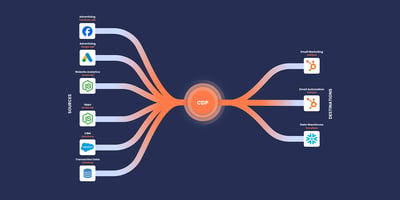Understanding the customer experience is the key to refining your sales practices. It's important to have a sense of what your customers are thinking, doing, and experiencing during each phase of the sales funnel. A customer journey map can help you present complex data in a visual format that engages your entire team.
What is a Customer Journey Map?
A customer journey map is a visual representation of the sales process, giving your marketing team and sales force an inside look at the feelings, concerns, and habits of different customer types. Putting together a customer journey map is no small task. It involves an extensive amount of data and interpretation. The information that you uncover while creating a customer journey map is extremely valuable, and will drive customer engagement.
What Does a Good Map Contain?
If you were to go searching for templates or examples, you'd come away frustrated. Customer journey maps are complex, and the sheer amount of designs to choose are innumerable. Before you begin creating your map, it's more valuable to understand the key elements that a map should contain. Those elements are:
● Customer persona
● Phases of the sales process
● Touchpoints with your customers
● Customer actions
● Pain points (objections to purchasing)
● Customer's emotions and frustration level
● Opportunities to improve your process
With important information in hand, you have a clearer picture of how to proceed. Let's take a look at the steps involved in the actual creation process.
The Steps to Creating a Customer Journey Map
Design comes last
This process is all about the journey, for both you and your customer. Don't start with the end in mind; focus on gathering and interpreting data. The process drives the format that you'll use for your map.
Use high-quality data
Remember: less is more. Rather than surveying dozens of people using superficial interview questions, focus on high-quality data using a smaller sample size. You'll be amazed at the insights you discover in the process.
Involve internal stakeholders
Don't just focus on the customer's perspective. Your sales force and customer service representatives are also involved in the sales process. To understand your customer's journey, it's essential to get a multitude of perspectives. This is a case in point of using high-quality, qualitative data.
Eliminate bias through careful survey practices and hosted conversations
It's important to use the right tools and methodology when gathering customer data. If you aren't careful in your approach, you run the risk of introducing bias into your map. One way to go about it is to create a survey tool that's purposefully free of internal bias, but it's much more useful to hold direct conversations with your customers. Interviews have an us-versus-them feeling. If you're able to turn the interaction into a conversation, you'll reap the reward of a give-and-take relationship with your customer.
Communicate its importance to every team member
It's important to elicit buy-in from your entire team. Look for ways to anchor the data in your customer journey map to each individual role or department to demonstrate the project's value to everyone.
Be thorough, take your time
Developing a customer journey map is a marathon, not a sprint. The kind of data gathering necessary to create a good, actionable map takes time. Embrace the time spend; your efforts will be well worth it.
Figure out your point of entry
Once you've gathered all the facts, it's time to define what your process looks like. Where is the customer's point of entry regarding adoption of your product, services, or company? Clarity will help you solidify the structure of your map.
Make multiple maps for multiple customer types
To be effective, a customer journey map should focus on a customer persona or type. If your focus is too wide, the map loses its value. Therefore, you might have to make multiple maps to address different customer segments.
Present the finished product
Once you've completed your work, it's time to implement the finished product. How you put your customer journey map to use within your organisation is your choice, but whatever you do, make the data actionable.
Final Thoughts
Today's customers have more information and choice available to them than ever before. So your relationship is filled with an additional level of complexity. Developing a customer journey map helps you to clarify that relationship while providing you with actionable information in the process.
For more ways to help streamline your marketing process feel free to reach out to me.





